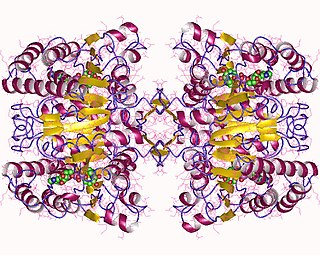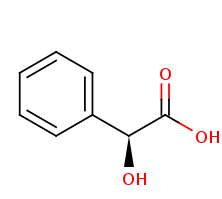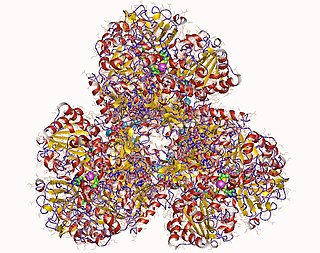
Oxaloacetic acid (also known as oxalacetic acid or OAA) is a crystalline organic compound with the chemical formula HO2CC(O)CH2CO2H. Oxaloacetic acid, in the form of its conjugate base oxaloacetate, is a metabolic intermediate in many processes that occur in animals. It takes part in gluconeogenesis, the urea cycle, the glyoxylate cycle, amino acid synthesis, fatty acid synthesis and the citric acid cycle.

Glyoxylic acid or oxoacetic acid is an organic compound. Together with acetic acid, glycolic acid, and oxalic acid, glyoxylic acid is one of the C2 carboxylic acids. It is a colourless solid that occurs naturally and is useful industrially.

In enzymology, a glycerate dehydrogenase (EC 1.1.1.29) is an enzyme that catalyzes the chemical reaction

Glyoxylate reductase, first isolated from spinach leaves, is an enzyme that catalyzes the reduction of glyoxylate to glycolate, using the cofactor NADH or NADPH.
In enzymology, a glyoxylate reductase (NADP+) (EC 1.1.1.79) is an enzyme that catalyzes the chemical reaction
In enzymology, a hydroxypyruvate reductase (EC 1.1.1.81) is an enzyme that catalyzes the chemical reaction

In enzymology, a tartrate dehydrogenase (EC 1.1.1.93) is an enzyme that catalyzes the chemical reaction
In enzymology, a choline dehydrogenase is an enzyme that catalyzes the chemical reaction
In enzymology, a malate dehydrogenase (quinone) (EC 1.1.5.4), formerly malate dehydrogenase (acceptor) (EC 1.1.99.16), is an enzyme that catalyzes the chemical reaction

In enzymology, (S)-mandelate dehydrogenase (MDH), is an enzyme that catalyzes the chemical reaction.

In enzymology, a formate dehydrogenase (cytochrome) (EC 1.2.2.1) is an enzyme that catalyzes the chemical reaction
In enzymology, a glycolaldehyde dehydrogenase (EC 1.2.1.21) is an enzyme that catalyzes the chemical reaction
In enzymology, a glyoxylate dehydrogenase (acylating) (EC 1.2.1.17) is an enzyme that catalyzes the chemical reaction

In enzymology, an oxalate oxidase (EC 1.2.3.4) is an oxalate degrading enzyme that catalyzes the chemical reaction:
In enzymology, a hydrogen dehydrogenase (EC 1.12.1.2) is an enzyme that catalyzes the chemical reaction
In enzymology, a cytokinin dehydrogenase (EC 1.5.99.12) is an enzyme that catalyzes the chemical reaction
In enzymology, a glycine dehydrogenase (EC 1.4.1.10) is an enzyme that catalyzes the chemical reaction
In enzymology, a glycine dehydrogenase (cytochrome) (EC 1.4.2.1) is an enzyme that catalyzes the chemical reaction

In enzymology, a methylenetetrahydrofolate dehydrogenase (NADP+) (EC 1.5.1.5) is an enzyme that catalyzes the chemical reaction

In enzymology, a NADPH dehydrogenase (EC 1.6.99.1) is an enzyme that catalyzes the chemical reaction










